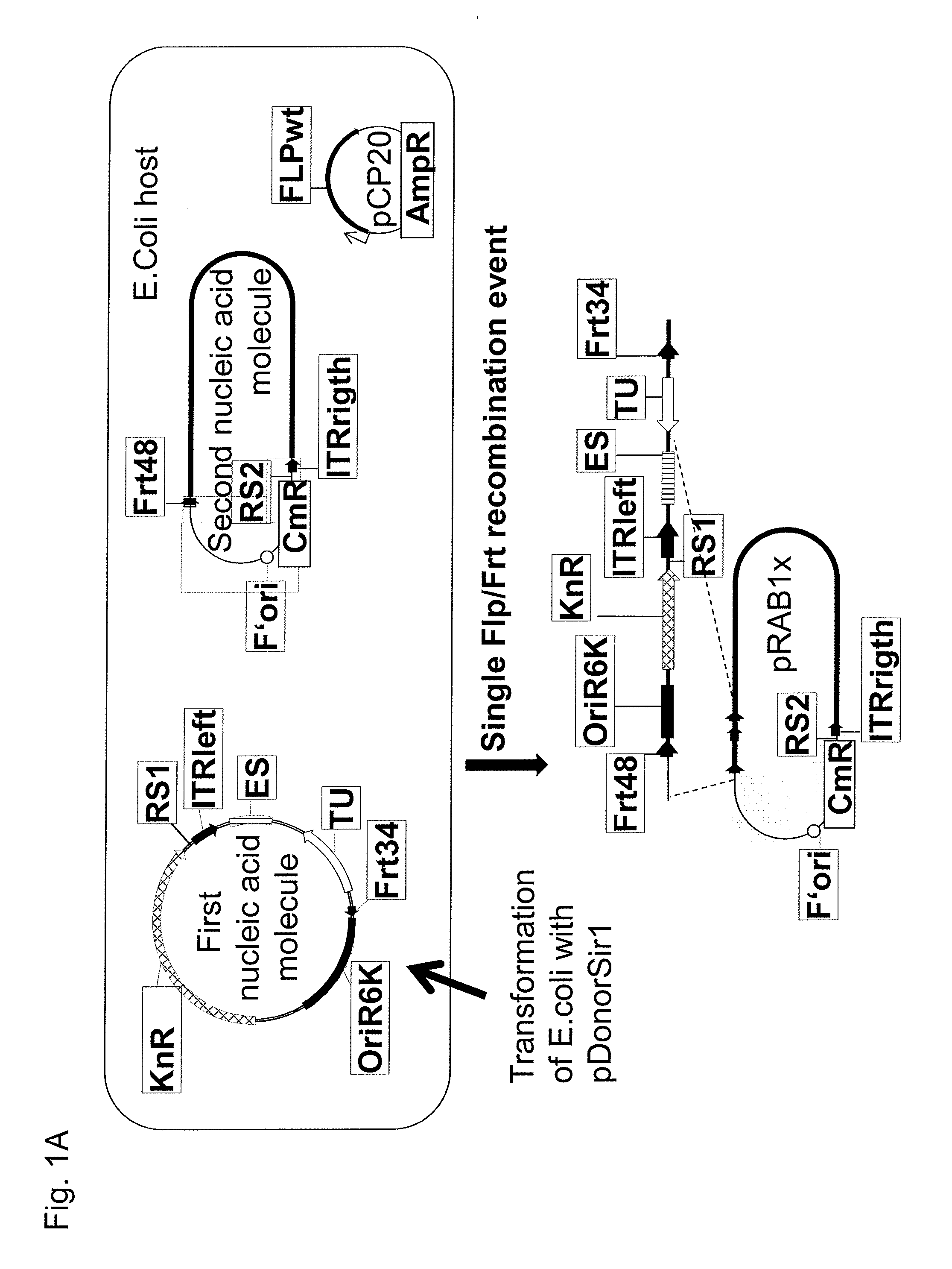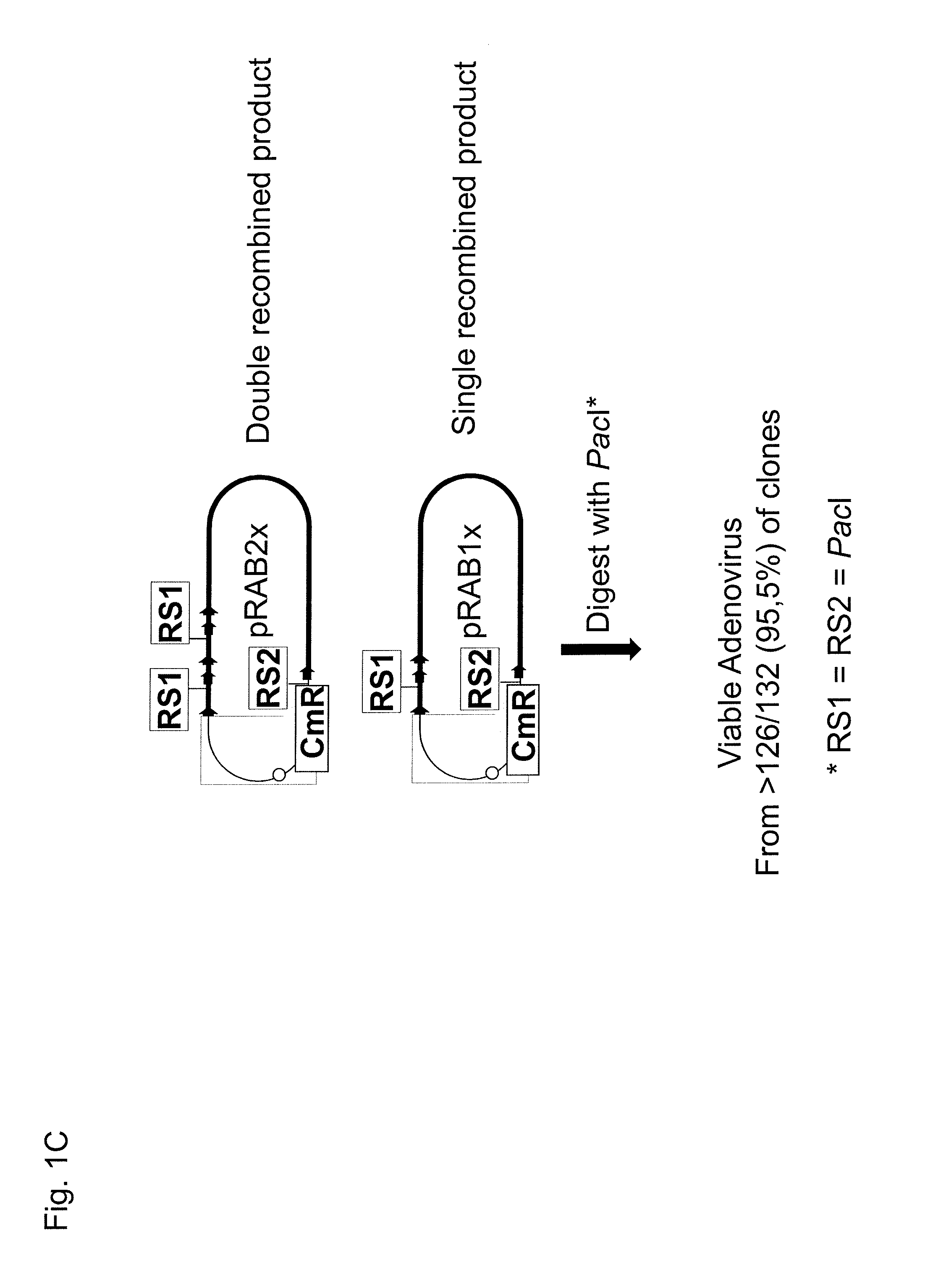Means for generating adenoviral vectors for cloning large nucleic acids
a technology of adenovirus and vector, which is applied in the direction of viruses/bacteriophages, biochemistry apparatus and processes, dsdna viruses, etc., can solve the problems of time-consuming and laborious use of this method to generate large numbers of recombinant adenovirus vectors, and achieve the effect of high efficiency
- Summary
- Abstract
- Description
- Claims
- Application Information
AI Technical Summary
Benefits of technology
Problems solved by technology
Method used
Image
Examples
example 1
Construction of Recombinant Adenovirus BACs Using Site-Specific Recombination in E. coli Expressing Flp Recombinase
[0510]For construction of a recombinant adenovirus genome, a first nucleic acid pDonorSir1 and a second nucleic acid molecule pBACSir1 were combined and reacted in DH10B E. coli cells harbouring pBACSir1 and the plasmid pCP20 for conditional expression of FLP recombinase, whereby pDonorSir1 is identical to the deposited organism at the DSMZ with the accession number according to the Budapest treaty DSM 23753, and whereby pBACSir1 is identical to the deposited organism at the DSMZ according to the Budapest treaty with the accession number DSM24298, and whereby E. coli cells harbouring pBACSir1 and pCP20 are identical to the deposited organism at the DSMZ according to the Budapest treaty with the accession number DSM 23742. The plasmid pDonorSir1 was introduced into the DH10B E. coli cells by means of electroporation using a standard protocol. The nucleic acid molecule pB...
example 2
Reconstitution of Recombinant Adenoviruses Generated by Site-Specific Recombination in E. coli Expressing Flp Recombinase
[0511]The two predominant types of BAC vectors obtained from site-specific recombination according to the disclosed method in example 1 were pRAB1× and pRAB2×, respectively. The pRABs generated by the Flp-recombination in DH10B cells contained one, and only one continuous sequences of a complete complemented adenovirus genome, which was replication competent in 293 cells. The DNA of pRABs was purified from saturated E. coli over night cultures (100 ml) in LB medium using a kit for plasmid preparation. Here, the Nucleobond PC-100 kit from Macherey and Nagel, Germany was used according to the manufacturer's recommendations. The identity of the pRBAs obtained was verified by means of restriction analysis of the pRAB DNAs (FIG. 2A, lanes 2-4). For virus reconstitution purified pRAB DNA was treated with 10 U PacI per μg DNA for 2 h according to the manufacture's recomm...
example 3
Generation of Recombinant RABs with Controlled Recombination Through Negative Selection
[0512]To avoid multiple insertions and improve the construction of an adenovirus expression library, we constructed pDonorSir2 which is an embodiment of the third nucleic acid molecule of the present invention, whereby pDonorSir2 is identical to the deposited organism at the DSMZ according to the Budapest treaty with the accession number DSM 23754. pDonorSir2 differs from pDonorSir1 at its FRT locus, next to this pDonorSir2 contains a strong E. coli galaktokinase promoter (Warming, S., N. Costantino, Court D L, N. A. Jenkins, and N. G. Copeland. Simple and highly efficient BAC recombineering using galK selection. Nucleic Acids Res 2005, 33:e36) upstream to the FRT site and downstream of the FRT site a rpsL open reading frame, which mediated Streptomycin sensitivity if expressed (Reyrat J M, Pelicic V, Gicquel B, Rappuoli R. Counterselectable markers: untapped tools for bacterial genetics and patho...
PUM
 Login to view more
Login to view more Abstract
Description
Claims
Application Information
 Login to view more
Login to view more - R&D Engineer
- R&D Manager
- IP Professional
- Industry Leading Data Capabilities
- Powerful AI technology
- Patent DNA Extraction
Browse by: Latest US Patents, China's latest patents, Technical Efficacy Thesaurus, Application Domain, Technology Topic.
© 2024 PatSnap. All rights reserved.Legal|Privacy policy|Modern Slavery Act Transparency Statement|Sitemap



